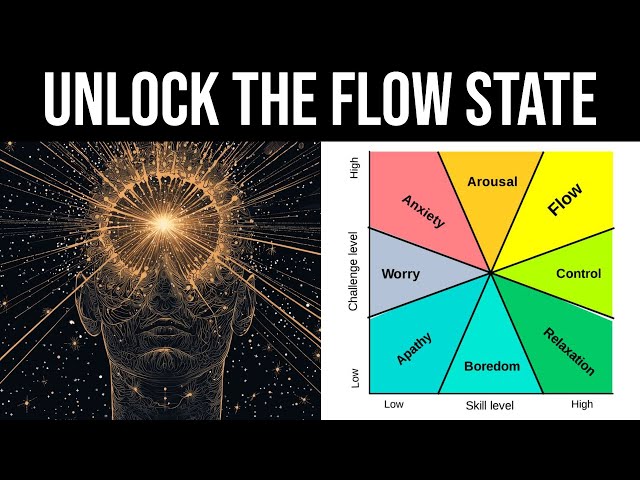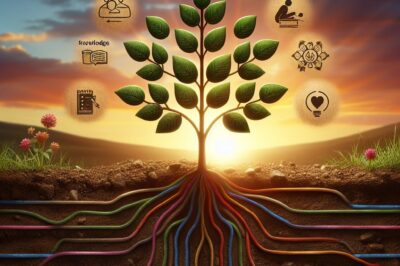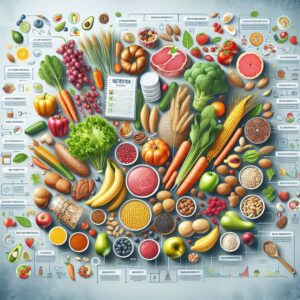Key Takeaways
- Flow state is a mental condition where one is fully immersed in an activity, often leading to enhanced performance and enjoyment.
- Key components of flow include a balance between challenge and skill, clear goals, and immediate feedback.
- Achieving flow can improve creativity, increase productivity, and boost overall well-being.
- Activities that are intrinsically rewarding and require focus can trigger flow, such as playing sports, engaging in creative arts, or solving complex problems.
- To enhance focus and achieve flow, reduce distractions, set clear goals, and maintain high concentration.
What is Flow State?
Flow state is a fascinating mental condition where you become so absorbed in an activity that everything else seems to fade away. It’s that magical moment when you’re “in the zone” and everything just clicks. Whether you’re painting, playing a sport, or even working on a challenging project, flow state can transform the way you experience and perform tasks.

“Peaceful Flow Stock Illustrations – 34 …” from www.dreamstime.com and used with no modifications.
Definition and Importance
Flow state, a term popularized by psychologist Mihaly Csikszentmihalyi, describes a state of complete immersion in an activity. It’s when you’re so focused that time flies by, and you’re working at your peak performance. But why is this important? Because achieving flow can lead to higher productivity, greater creativity, and an increased sense of satisfaction in whatever you’re doing.
Components of Flow State
Flow isn’t just about being focused; it’s a complex interplay of various factors. Here are some key components:
- Challenge-Skill Balance: The activity must be challenging yet achievable, matching your skill level.
- Clear Goals: You need to know what you’re aiming for, with specific objectives in mind.
- Immediate Feedback: Receiving feedback as you work helps you adjust and improve in real-time.
- Deep Concentration: Distractions are minimized, allowing you to fully focus on the task at hand.
These elements combine to create an environment where flow can naturally occur, leading to enhanced performance and enjoyment.
Benefits of Achieving Flow
Why should you strive to achieve flow? The benefits are numerous. When you’re in a flow state, you’re not only more productive but also more creative. Your mind becomes a powerhouse of ideas, and tasks that once seemed daunting become manageable and even enjoyable. Besides that, flow can improve your mood and overall well-being, making you feel more fulfilled and satisfied with your work and life.

“The Art of Enjoyment” from www.newindianexpress.com and used with no modifications.
How Flow State Improves Enjoyment
One of the most appealing aspects of flow state is the sheer enjoyment it brings. When you’re fully engaged in an activity, you experience a sense of pleasure and fulfillment that’s hard to match. This enjoyment comes from the intrinsic motivation that drives you to continue the activity, not because you have to, but because you want to.
Activities that Trigger Flow
Not all activities can trigger flow. It requires a delicate balance between challenge and skill. Here are some activities that often lead to flow:
- Sports: Whether it’s basketball, soccer, or swimming, sports require focus, skill, and quick decision-making, all of which can lead to flow.
- Creative Arts: Painting, writing, or playing a musical instrument can immerse you in a world of creativity and concentration.
- Puzzles and Games: Solving complex puzzles or playing strategy games can challenge your mind and keep you engaged.
These activities are intrinsically rewarding, meaning you do them for the sheer joy they bring, making them perfect candidates for achieving flow.
Setting Clear Goals
Setting clear goals is fundamental to achieving a flow state. When you know exactly what you’re aiming for, it becomes easier to focus and channel your energy effectively. Clear goals act as a roadmap, guiding your actions and helping you stay on track. They also provide a sense of purpose, which is crucial for maintaining motivation and drive.
Imagine you’re working on a project with a vague objective. It’s easy to get distracted or lose interest because you don’t have a clear endpoint. However, when you have a specific goal, such as completing a certain number of tasks or reaching a particular milestone, you’re more likely to stay engaged and motivated.
To set clear goals, break down your larger objectives into smaller, manageable tasks. This not only makes the process less overwhelming but also allows you to experience a sense of achievement as you complete each step. Remember, clarity is key to staying focused and achieving flow.

“Unlock Your Brain: Flow State …” from www.youtube.com and used with no modifications.
Maintaining High Concentration
Concentration is the backbone of flow. To maintain high concentration, it’s important to eliminate distractions and create an environment conducive to focus. Start by identifying what typically distracts you—be it your phone, social media, or noise—and take steps to minimize these interruptions.
One effective strategy is to set specific times for checking emails or social media, rather than allowing them to disrupt your workflow. You can also use tools like noise-canceling headphones or ambient sound apps to block out background noise and help you stay focused. For more on maintaining focus, explore these adaptability tips to cultivate an adaptable mindset.
Most importantly, practice mindfulness to train your mind to concentrate better. Simple mindfulness exercises, like focusing on your breath or observing your thoughts without judgment, can enhance your ability to concentrate and stay present in the moment. For more insights on cultivating a flexible mindset, explore these adaptability tips.
Boosting Work Productivity through Flow
Flow state is not just about enjoyment; it’s a powerful tool for boosting productivity. When you’re in flow, you’re working at your optimal level, which naturally leads to higher output and efficiency. This is because you’re fully engaged and motivated, allowing you to accomplish more in less time.
Moreover, flow can help you overcome procrastination and enhance your problem-solving abilities. By being deeply immersed in your work, you’re more likely to find creative solutions and innovative ideas that you might have missed otherwise. Therefore, cultivating flow in your daily tasks can significantly improve your work productivity and overall performance. If you’re looking to improve your adaptability, consider these tips to cultivate an adaptable mindset.
Challenge-Skill Balance
Achieving the right balance between challenge and skill is crucial for entering a flow state. If a task is too easy, you might get bored. If it’s too difficult, you may feel anxious or overwhelmed. Flow occurs when the challenge of the task matches your skill level, pushing you to stretch your abilities without causing stress.
To find this balance, assess your current skills and choose tasks that are slightly above your comfort zone. This will encourage growth and keep you engaged. For example, if you’re a writer, try tackling a new genre or writing style that you haven’t explored before. This not only enhances your skills but also keeps you motivated and focused.
Receiving Unambiguous Feedback
Feedback plays a vital role in achieving flow. It helps you gauge your progress and make necessary adjustments to improve your performance. When feedback is clear and unambiguous, it provides a sense of direction and helps you stay aligned with your goals.
Seek feedback from peers, mentors, or supervisors who can offer constructive insights. Additionally, self-assessment can be a valuable tool. Reflect on your performance regularly and identify areas for improvement. This continuous feedback loop ensures that you stay on the right track and maintain your flow.
Creating an Optimal Environment
Your environment significantly impacts your ability to achieve flow. An optimal environment is one that minimizes distractions and promotes focus. Start by organizing your workspace to ensure it’s tidy and clutter-free. A clean space can help clear your mind and improve concentration.
Lighting and temperature also play a role in creating a conducive environment. Ensure your workspace is well-lit, preferably with natural light, and maintain a comfortable temperature to prevent discomfort from disrupting your focus.
Lastly, personalize your space with elements that inspire you, such as motivational quotes, plants, or artwork. These personal touches can boost your mood and motivation, making it easier to enter a flow state.

“How to Achieve Your Dreams – Some Key …” from www.successconsciousness.com and used with no modifications.
Tips for Achieving Flow State
Achieving flow is not always easy, but with the right strategies, you can increase your chances of entering this productive state. Here are some practical tips to help you achieve flow more consistently:
Practice Mindfulness and Presence
Mindfulness is a powerful tool for achieving flow. By practicing mindfulness, you train your mind to stay present and focused on the task at hand. This reduces distractions and enhances your ability to concentrate.
“Mindfulness is the art of being present in the moment. It allows you to fully engage with your task, increasing the likelihood of achieving flow.” – Researcher in Cognitive Psychology
Start with simple mindfulness exercises, such as deep breathing or body scans, to cultivate a sense of presence. Over time, this practice will help you stay more focused and enhance your ability to achieve flow.
Engage in Regular Physical Activity
Physical activity is not only beneficial for your physical health but also for your mental well-being. Regular exercise can improve your mood, reduce stress, and increase your ability to concentrate, all of which are conducive to achieving flow.
Incorporate activities like jogging, yoga, or even a short walk into your daily routine. These activities help clear your mind, boost your energy levels, and prepare you for focused work sessions. For more tips on maintaining a positive mindset, explore these optimism techniques.
Schedule Focused Work Sessions
Scheduling dedicated work sessions can significantly enhance your ability to achieve flow. Allocate specific times in your day for focused work, free from interruptions and distractions.
During these sessions, use techniques like the Pomodoro Technique, which involves working for a set period (e.g., 25 minutes) followed by a short break. This approach helps maintain concentration and prevents burnout, making it easier to enter and sustain flow.
Avoid Multitasking
Multitasking might seem like a great way to get more done, but it can actually hinder your ability to achieve flow. When you split your attention between tasks, you reduce your capacity to fully engage with any one of them. This divided focus prevents the deep concentration necessary for flow.
Instead, focus on one task at a time. Prioritize your tasks and tackle them sequentially. This approach not only enhances your productivity but also increases your chances of entering a flow state. Remember, quality often trumps quantity when it comes to effective work.
Final Thoughts on Flow State and Productivity
Flow state is a powerful mental condition that can transform how you work and live. By understanding its components and implementing strategies to achieve it, you can enhance your productivity, creativity, and overall well-being. The journey to flow is personal, requiring patience and practice, but the rewards are well worth the effort. For more insights on improving your mindset, explore these adaptability tips.
Key Insights and Recommendations
To consistently achieve flow, it’s essential to create an environment and mindset conducive to deep focus and engagement. Here are some key insights and recommendations:
- Align tasks with your skill level to find the right challenge-skill balance.
- Set clear, achievable goals to maintain focus and motivation.
- Minimize distractions and create a workspace that promotes concentration.
- Practice mindfulness and presence to enhance your ability to concentrate.
- Seek feedback and reflect on your performance to stay aligned with your goals.
Long-term Benefits of Regular Flow Experiences
Regular experiences of flow can have profound long-term benefits. Not only do they improve your productivity and performance, but they also contribute to a greater sense of fulfillment and satisfaction. By incorporating flow into your daily life, you can enhance your mental and emotional well-being, leading to a more balanced and enjoyable life.

“A peaceful flow: River winding through …” from www.reddit.com and used with no modifications.
Frequently Asked Questions (FAQ)
As you embark on your journey to achieving flow, you might have some questions. Here are some common queries and their answers:
What are the typical signs of being in a flow state?
When you’re in a flow state, you experience deep concentration, a sense of control over the task, and a loss of self-consciousness. Time often seems to fly by, and you feel fully immersed in the activity, leading to a sense of fulfillment and enjoyment.
Can flow state be experienced during leisure activities?
Absolutely! Flow can be experienced in various activities, not just work-related tasks. Hobbies like painting, playing an instrument, or even gardening can trigger flow, as long as they provide the right balance of challenge and skill.
How does flow state differ from mindfulness?
While both flow state and mindfulness involve focus, they differ in their approach. Flow is about being fully absorbed in an activity, often leading to enhanced performance. Mindfulness, on the other hand, is about being present and aware, without necessarily being focused on a specific task. For more insights on how different brain areas and functions contribute to these states, explore our detailed guide.
What are some common obstacles to achieving flow?
Distractions, lack of clear goals, and an imbalance between challenge and skill are common obstacles. Additionally, stress and fatigue can hinder your ability to concentrate, making it difficult to enter a flow state. Learning how to cultivate an adaptable mindset can help overcome these challenges.
How long does it usually take to enter a flow state?
The time it takes to enter a flow state varies depending on the individual and the activity. Some people may achieve flow within minutes, while others might take longer. The key is to create an environment and mindset that fosters deep concentration and engagement. Understanding how different brain areas and functions contribute to concentration can also aid in achieving a flow state more effectively.










Leave a Reply